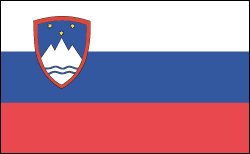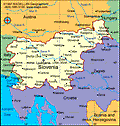Slovenia | Facts & Information

- Slovenia Profile
- History
- News and Current Events
Facts & Figures
-
President: Borut Pahor (2012)
Prime Minister: Miro Cerar (2014)
Land area: 7,780 sq mi (20,151 sq km); total area: 7,827 sq mi (20,273 sq km)
Population (2014 est.): 1,988,292 (growth rate: -0.23%); birth rate: 8.54/1000; infant mortality rate: 4.04/1000; life expectancy: 77.83
Capital and largest city (2011 est.): Ljubljana 273,000
Monetary unit: Slovenian tolar; euro (as of 1/1/07)
National name: Republika Slovenija
Languages: Slovenian 91.1%, Serbo-Croatian 4.5%, other or unspecified 4.4% (2002)
Ethnicity/race: Slovene 83.1%, Serb 2%, Croat 1.8%, Bosniak 1.1%, other or unspecified 12% (2002 census)
Religions: Catholic 57.8%, Muslim 2.4%, Orthodox 2.3%, other Christian 0.9%, unaffiliated 3.5%, other or unspecified 23%, none 10.1% (2002 census)
Literacy rate: 99.7% (2011 est.)
Economic summary: GDP/PPP (2013 est.): $57.36 billion; per capita $27,400. Real growth rate: -1.1%. Inflation: 1.8%. Unemployment: 13.1%. Arable land: 8.31%. Agriculture: potatoes, hops, wheat, sugar beets, corn, grapes; cattle, sheep, poultry. Labor force: 934,700 (2011 est.); agriculture 2.2%, industry 35%, services 62.8% (2019). Industries: ferrous metallurgy and aluminum products, lead and zinc smelting; electronics (including military electronics), trucks, electric power equipment, wood products, textiles, chemicals, machine tools. Natural resources: lignite coal, lead, zinc, building stone, hydropower, forests. Exports: $28.73 billion (2013 est.): manufactured goods, machinery and transport equipment, chemicals, food. Imports: $29.49 billion (2013 est.): machinery and transport equipment, manufactured goods, chemicals, fuels and lubricants, food. Major trading partners: Germany, Italy, Austria, France, Croatia, Russia, Hungary (2012).
Communications: Telephones: main lines in use: 825,000 (2012); mobile cellular: 2.246 million (2012). Broadcast media: Public television broadcaster, Radiotelevizija Slovenija (RTV), operates a system of national and regional TV stations; 35 domestic commercial television stations operating nationally, regionally, and locally; about 60% of households are connected to multi-channel cable TV systems; public radio broadcaster operates 3 national and 4 regional stations; more than 75 regional and local commercial and non-commercial radio stations (2007). Internet Service Providers (ISPs): 415,581 (2012). Internet users: 1.298 million (2009).
Transportation: Railways: total: 1,228 km (2007). Highways: total: 38,985; paved: 38,985 km (includes 769 km of expressways) (2012). Waterways: (there is some transport on the Drava River) (2012). Ports and harbors: Koper. Airports: 16 (2013).
International disputes: since the breakup of Yugoslavia in the early 1990s, Croatia and Slovenia have each claimed sovereignty over Pirin Bay and four villages, and Slovenia has objected to Croatia's claim of an exclusive economic zone in the Adriatic Sea; in 2009, however Croatia and Slovenia signed a binding international arbitration agreement to define their disputed land and maritime borders, which led to Slovenia lifting its objections to Croatia joining the EU; as a member state that forms part of the EU's external border, Slovenia has implemented the strict Schengen border rules to curb illegal migration and commerce through southeastern Europe while encouraging close cross-border ties with Croatia; Slovenia continues to impose a hard border Schengen regime with Croatia, which joined the EU in 2013 but has not yet fulfilled Schengen requirements.









